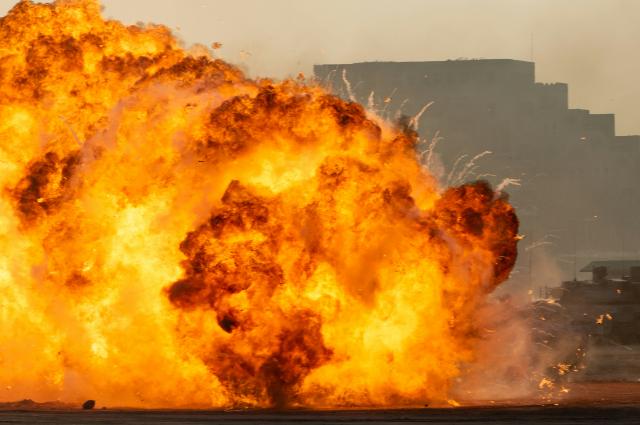
Photo by Jeff Kingma on Unsplash
On a 15th November night in Nowgam, near Srinagar, what should have been a routine examination of confiscated explosives turned into one of Jammu and Kashmir's deadliest security disasters. Nine people lost their lives and thirty-two others sustained injuries when a massive cache of seized explosives detonated at a police station. The victims weren't civilians caught in crossfire, they were the very people tasked with protecting society which included police officers, forensic experts, and government officials doing their jobs.
The casualty list reads like a roll call of public service that included a State Investigation Agency official, three forensic science laboratory specialists, two crime branch officers, two revenue department officials, and even a tailor who worked with the investigation team. These weren't people in the wrong place at the wrong time; they were professionals handling dangerous materials that had been transported from Faridabad, Haryana. The explosion sent the wounded people to the Indian Army's 92 Base Hospital and the Sher-i-Kashmir Institute of Medical Sciences, marking a catastrophic failure in explosive handling protocols.
Unravelling a White-Collar Terror Network
To understand how these explosives ended up in that Nowgam police station, we must trace the investigation backward. It began with something seemingly inoffensive posters. When authorities in Jammu and Kashmir discovered propaganda materials related to Jaish, they launched an investigation that would expose what police described as a "white-collar terror ecosystem", a chilling phrase that captures the modern face of terrorism. This wasn't a network of militants hiding in caves; these were educated professionals doctors, no less than radicalised and operating under the direction of foreign handlers based in Pakistan and neighbouring countries.
CCTV footage from areas where these posters appeared led investigators to a doctor named Rather, who had worked at the Government Medical College in Anantnag until October of the previous year before relocating to Saharanpur in Uttar Pradesh. His arrest unveiled an alarming detail; an assault rifle concealed in his locker at the medical college. The discovery raised disturbing questions about how deeply terror networks had penetrated professional institutions.
The Faridabad Connection: 3,000 Kilograms of Potential Destruction
Rather's interrogation pointed investigators toward another medical professional, Dr. Muzammil Shakeel, employed at Al-Falah Medical College in Faridabad, Haryana. When joint teams from Jammu and Kashmir and Haryana police raided properties linked to Shakeel, they made a staggering discovery which included nearly 3,000 kilograms of ammonium nitrate, a chemical commonly used as fertilizer but equally notorious as a key ingredient in improvised explosive devices.
To put this quantity in perspective, the 1995 Oklahoma City bombing, one of the deadliest domestic terror attacks in American history, used roughly 2,300 kilograms of ammonium nitrate. The Faridabad seizure represented enough material to cause catastrophic damage on a massive scale. This was the supply that would eventually be transported to the Nowgam police station and the same explosives that would claim nine lives during examination.
Shakeel's arrest triggered further revelations, leading to the apprehension of Dr. Shaheen Saeed, another colleague at the same Faridabad institution. The investigation was exposing a network that had successfully embedded itself within the medical profession, using the respectability of white-collar careers as cover for deadly intentions.
The Red Fort Blast: Panic and Improvisation
Hours after Saeed's arrest, chaos erupted at one of Delhi's most iconic locations. A car stopped at a traffic signal near the Red Fort exploded in a jam-packed area, killing thirteen people and injuring over twenty others. Multiple vehicles were damaged in the blast, which occurred in one of the capital's busiest tourist zones.
The explosion led investigators to another doctor Umar Nabi. He was identified as the driver of the Hyundai i20 where the blast originated. According to National Investigation Agency sources, the seizure of the 3,000-kilogram chemical stockpile in Faridabad likely created a "panic situation" for the terror network. The suspects realising their massive cache had been discovered, apparently rushed to relocate or deploy remaining explosives before authorities could track them all down.
The Fatal Flaw: An Improperly Assembled Device
Investigators examining the Red Fort blast found telling evidence of hasty, amateur work. The nature of the explosion suggested the improvised explosive device had been assembled improperly. In their panic, the suspects appeared unable to arm the IED for maximum destructive capacity, an unattractive silver lining that likely prevented even greater casualties. Had the device been properly constructed by someone with adequate time and technical knowledge, the death toll could have been exponentially higher.
Reflections on a Preventable Tragedy
This interconnected series of events from poster propaganda to the Faridabad chemical seizure to the Red Fort explosion to the Nowgam police station blast illustrates the complex, multi-layered nature of modern terrorism. What's particularly disturbing is the profile of those involved like medical professionals, individuals who took oaths to preserve life, allegedly conspiring to end it on a mass scale.
The Nowgam explosion that killed nine dedicated public servants represents the ultimate irony that explosives confiscated to prevent harm became instruments of tragedy. It raises urgent questions about protocols for handling, storing, and examining seized dangerous materials. Were proper safety measures followed? Was the storage facility adequate for such quantities? Were personnel sufficiently trained for handling materials of this magnitude?
As investigators continue piecing together this network's full scope, one thing is clear that the line between prevention and tragedy can be razor-thin, and the cost of miscalculation whether in security protocols or hasty terror plotting is measured in irreplaceable human lives.
. . .
References:
